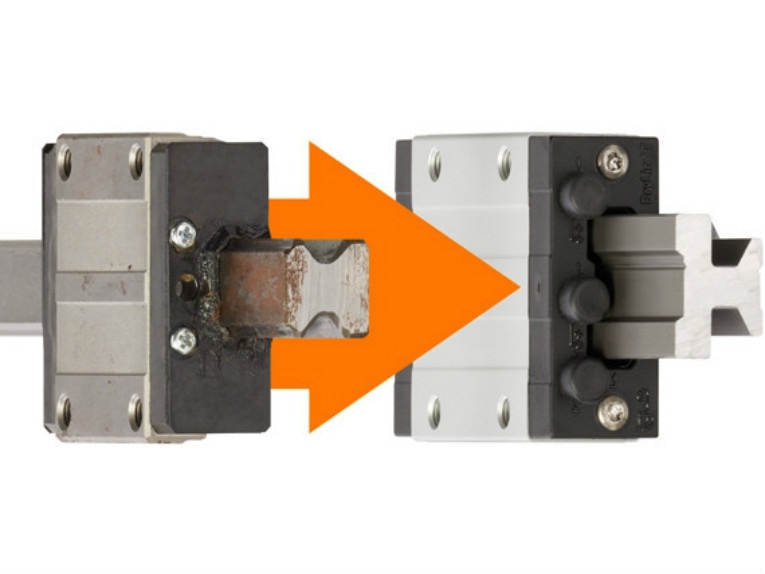Choices for linear bearings include bearing material, coatings, and sourcing.
Corrosion is an oxidation reaction that affects most metals. In the case of steel, the iron oxidizes when exposed to air and water to form rust, which can gradually destroy the material over time. The surfaces of steel linear bearings, for example, will degrade as a result of rust, increasing friction, contaminating the equipment and the environment, and reducing lifetime (see figure below). Even seemingly benign surface corrosion can be a problem in consumer-facing applications. If the conditions of your application are likely to cause rust or are sensitive to rust, consider a treatment for corrosion resistance.
Corrosion can’t be stopped entirely. There are ways to slow the process, however. In the course of this article, we will review some of the approaches to corrosion control, including the trade-offs involved.
Material Matters
The default linear bearing material is carbon steel. It’s very hard, so it’s suitable for high loads. The problem is that it rusts. —The chromium oxidizes to form an inert layer at the surface of the steel. This oxide layer helps prevent iron from diffusing the surface to form rust.
In addition to carbon steel, linear bearings can be made of martensitic (400 series) steel and austenitic (300 series) steel. Martensite has around 18% chromium but also higher levels of carbon. It is very hard but only moderately resistant to corrosion. Austenite has greater levels of chromium—as much as 26%—which lead to a thicker oxidation layer and higher oxidation resistance.
The trade-off for the increased corrosion resistance in austenitic linear bearings is reduced hardness. As a result, the dynamic and static load ratings of austenitic linear bearings are derated by about 80% and 85%, respectively. This isn’t necessarily a problem for lighter loads since we are still talking about load ratings in the hundreds of kilograms. In the case of heavier loads, increasing the number of blocks on each rail can help compensate for the derating.
Load ratings of martensitic linear bearings are the same as their carbon steel versions (no deration).
The biggest drawback with these two anti-corrosion options is that they can be quite a bit more expensive than carbon steel linear bearings. For budget-sensitive projects, a carbon-steel linear bearing treated with an anti-corrosion coating may be the best solution.
Anti-corrosion Coatings
There are two classes of anti-corrosion coatings:
Hard chrome plating
Moderate corrosion resistance (equivalent to that of martensitic stainless steel)
Hardness of 750 HV
Less expensive than martensitic linear bearing
Black chrome plating
Very good corrosion resistance (equivalent to that of austenitic stainless steel)
Significantly more expensive than hard chrome plating but less expensive than austenitic linear bearing
Making a decision on coatings requires trade-offs. A carbon steel linear bearing coated with hard chrome might be a good fit in moderate environment price-sensitive applications. For higher corrosion resistance, black chrome plated carbon steel offers corrosion resistance nearly equivalent to that of an austenitic linear bearing at a reduced price; the exact number varies depending on bearing size and complexity. For applications that require maximum lifetime, a black chrome coating over a martensitic linear bearing provides the highest possible protection.
Execution Matters
Anti-corrosion coatings can be effective solutions, but there are key factors to be aware of. First, coated bearings are not stock items. When the factory gets an order, it doesn’t pull a pre-assembled linear bearing from the shelves to apply protection. Manufacturers typically build a new linear bearing from scratch, coating the rails and blocks prior to final assembly. Depending on the factory, order specifics, and market demand, this can add weeks or even months to the delivery time. For customers who can’t afford this type of leadtime, adding an anti-corrosion coating as an aftermarket item provides an alternative.
Coating a finished linear bearing can be challenging. The linear bearing needs to be disassembled, sent out for coating, and then reassembled after its return. This process is straightforward but not easy, especially for linear bearings that are expected to meet tolerances on a micron scale. Another problem is that the coating thickness changes the dimensions of the races. Reassembling the linear bearing with the original balls will destroy the coating in a short period.
The only effective way to apply an after-market coating is to disassemble the bearings, coat the elements, then reassemble the bearing with smaller balls. The balls can be selected to fit the races or to apply an appropriate level of preload. This requires an inventory of balls with diameters in gradations of 1 µm, as well as the ability to test and approve the final product.
A final point worth mentioning is that all coatings have some variation in thickness across the part. As a result, a coated linear bearing may not meet the parallelism specifications of the base part. If your application has tight tolerances for parallelism but still presents risk of corrosion, it may be worth spending the extra money on an austenitic or martensitic linear bearing.
Corrosion protection is not a matter of choice. Oxidation is an ongoing process that will eventually limit the lifetime of equipment. If the environmental factors of an application introduce a probability of rust and material damage, it’s essential to decide on a strategy for dealing with it. Research the options and consult with your vendor to help make the correct choice for the application.
Post time: Mar-15-2021








